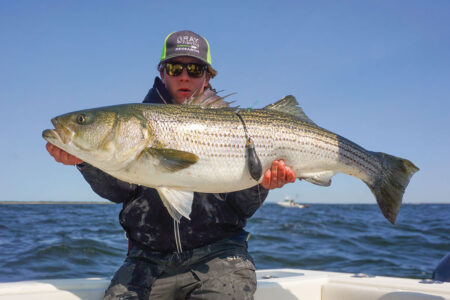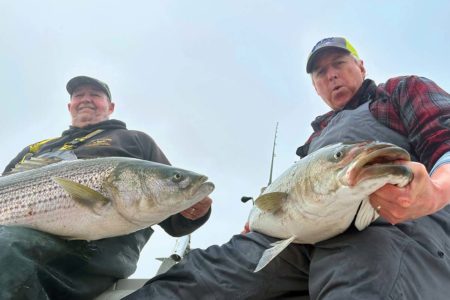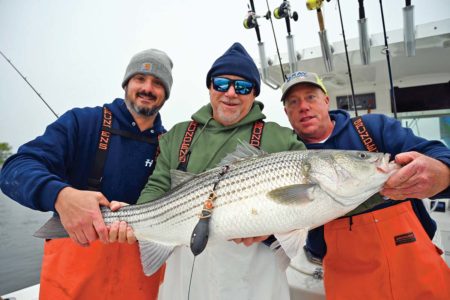By Jim Hutchinson, Jr. & Fred Golofaro
The premature emancipation of a satellite tagging device puts our Northeast Striped Bass Study team to the test.
“So we wait for tag returns while preparing for the next round of tagging sometime later this season…”
That’s part of the final line of our July feature write-up of the Northeast Striped Bass Study (’21 SAT Tags Deployed: Gray FishTag Research Returns) and our May 24th expedition to place high-tech MiniPSAT devices into a pair of big striped bass. As far as waiting for “tag returns,” we were hoping it would be about four months before the electrical charge released the satellite tag from the two fish.
But then came some unsettling news.
“On June 6, 2021, we began to see an uplink transmission from one of the two satellite tags we recently deployed. It was an unknown pre-mature tag release,” wrote Roxanne Willmer of Gray FishTag Research in an email to the team. The news came just as we were finalizing the July edition of The Fisherman and rather than rewrite the past, we quickly began assembling a team for the future.
The Eagle Has Landed
Premature tag releases are a part of the risks undertaken with satellite tag research efforts. When a tag is first released, it will begin sharing the data stored inside the unit with Argos satellites overhead by transmission uplinks. “This tag began transferring data near Great Kill Beach in Staten Island, New York, and within a day moved to a residential location in Staten Island,” Willmer explained, adding, “this told us that the tag was originally on the beach and now was in someone’s possession possibly in their home, car, garage etc.”
The Gray FishTag Research team watched these uplinks carefully and would spend the better part of a week looking for consistency and movements. With battery life of about two weeks to allow the info to be uplinked to the Argos satellites, the window for finding the actual MiniPSAT device was closing. And while transmissions are not fixed GPS locations – with variances up to a 1000-foot radius – it’s next to impossible to locate a pinpoint position of one of these tags, especially in a highly populated area like Staten Island. However, based on the daily updates to the Argos satellite, the Gray FishTag Research team was able to narrow down some streets and crossroads where we felt it was located.
By June 10th, Willmer and her team had reached out to Capt. Guy Buono of Krunch Sportfishing out of Great Kills, NY. One of several charter boat captains now working on the Northeast Striped Bass Study, Capt. Buono put up social media posts in hopes of finding someone who knew about the tag. Within days, flyers were up in local businesses and members of the fishing community were out and about, asking questions and hoping to find the device.
Late on Friday, June 11, an email arrived at Wildlife Computers, the manufacturer of the satellite tag. William Donnelly, a wildlife photographer based out of Staten Island, used the information printed on the MiniPSAT device, contacting Wildlife Computers to let them know that he was in possession of the tag. Tag sponsor and former New York Police Department lieutenant David Glassberg contacted a few close buddies, and the next morning he sent a text to the Northeast Striped Bass Study team with a simple message “eagle has been recovered,” along with a photo of Mr. Donnelly holding the tag outside of his Staten Island home. In exchange, the beachcombing wildlife photographer received a check for $250 and a pair of Costa sunglasses as a reward.
“When we began this study, we knew it had great importance and we were creating and collecting groundbreaking data on striped bass; but, now it is so much more special to us,” Willmer said later. “We are amazed at the crazy passion everyone involved has for the striped bass fishery but even more so for the passion they have for the success of our Gray FishTag Research tagging program.”
“Words cannot express having the support and interest of all these remarkable people helping put the pieces together and getting this tag back to us,” Willmer added. But it still leaves us with only one tagged fish still out there on the run from the May 24 deployment, and a need to improvise and adapt.
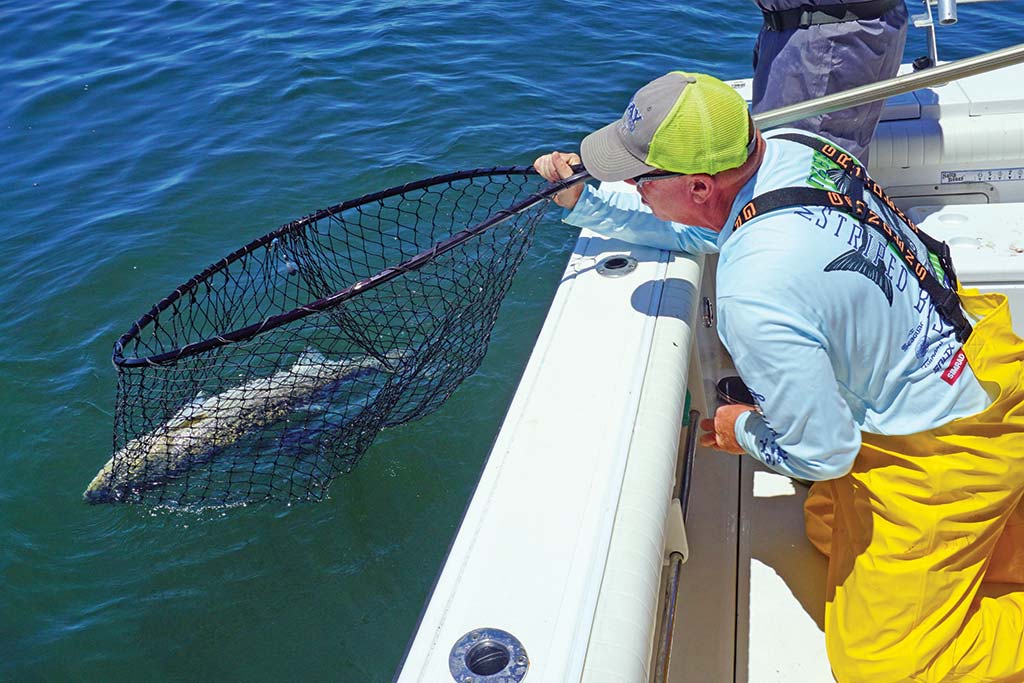
Down, Not Out
“Realizing the short duration this tag spent with the fish and our commitment to this study, we spoke with Chuck Many to see if he felt confident that we could locate another qualified candidate this late in the season for deployment of an additional satellite tag,” Willmer wrote in her update to the team. That question to Many was met with a resounding “yes” by a man who has become known all along the Atlantic Coast for his passion and penchant for finding jumbo stripers. With one satellite tag returned, another – the third in 2021 – was overnighted to Many by Monday morning, June 14th.
Together with Glassberg, Shawn DeVincenzo and myself, our team was back on the Shrewsbury Rocks off the northern New Jersey coast with a livewell full of eels just a bit after dawn on the 15th. We were still deploying our gear when the first planer disappeared from the surface and one of Many’s Shimano Torium reels started losing line. With DeVincenzo at the rod, we landed a 38-incher in a matter of minutes, but as I was shooting video I could see from the viewfinder that this girl only had one eye, not exactly a prime candidate for carrying a tag.
It was our only runoff, short the quick work the bluefish made of our eels and the thresher that came crashing through the spread later that morning. Down but not out, we spoke later at Gateway Marina while rinsing down the boat, about one more shot. With 2- to 6-pound bluefish now setting up in local waters, we figured the primary bodies of jumbo stripers had begun their travels north and east, but felt one more attempt for that Thursday was in the cards.
Two days later with Many and myself along with brothers Joel, Lee and Seth Wakefield, the Tyman left Gateway Marina at 4:45 a.m. in hopes of beating the bluefish to the breakfast table. We set the spread upon good marks at the Rocks, about 10 rods each with a flashing planer holding live eels down below the surface anywhere from 8 to 15 feet. In less than a half an hour, the bluefish ate roughly $50 worth of eels. The feisty piranha made eeling for jumbos an impossibility, so we made a fruitless run to the South Shore of Long Island, drifting and slow trolling the eels and planers not far from the Rockaway Reef. Two hours later with no takers under idyllic conditions pushed us towards Plan C, cast netting for live bunker and anchoring up along Romer Shoal inside Raritan Bay.
After weeding through some smaller fish, Lee Wakefield grabbed a screaming rod a little after noon on June 17, 2021 and we wrangled a 44-inch striped bass aboard the Tyman. With good length and yes, both of her eyeballs intact, the third Wildlife Computers MiniPSAT device of this year’s study was stuck into her fleshy shoulders and she was quickly revived along the starboard side gunnel. With a slap of the tail and a flash, the fish was gone, leaving two satellite devices in place along the Striper Coast from the spring run at the Jersey Shore.
A Return To Montauk
On Wednesday, June 30th, just a few days prior to the anniversary of Independence being tagged off of Montauk last year, we set out to place two Wildlife Computers MiniPSAT tags into another pair of big stripers on the eastern tip of Long Island. Montauk’s rips had been yielding good numbers of quality bass for a couple of weeks so confidence was running high among a crew made up of Mike Caruso, publisher of The Fisherman, senior editor Fred Golofaro, and Capt. John Paduano of Premium Charters and Bucktails, who was serving as guide for the day.
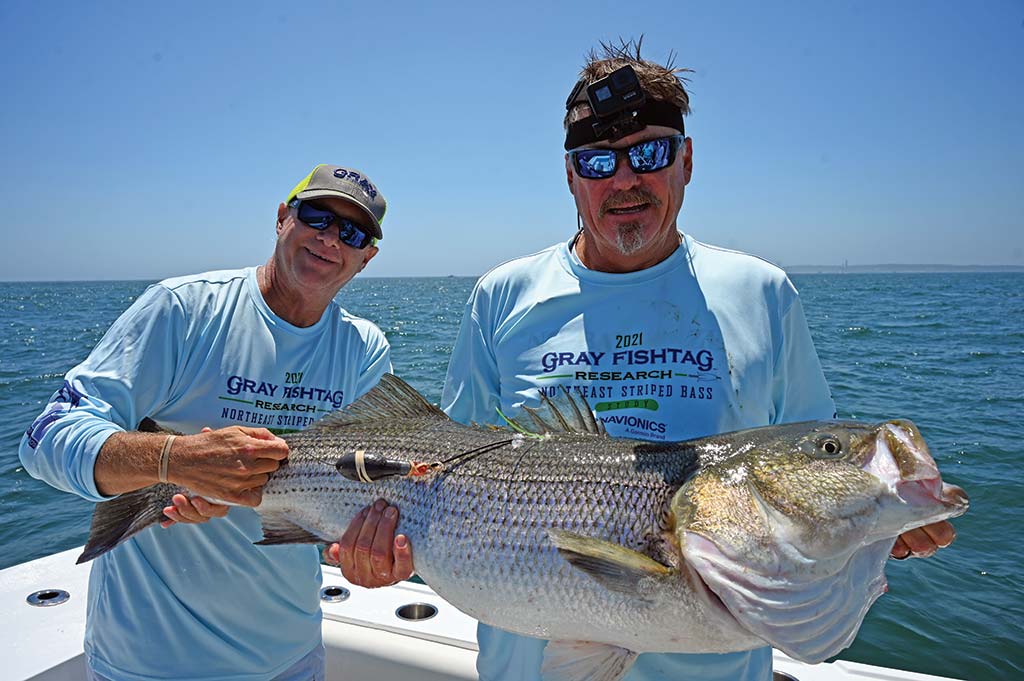
Making the trip up from Florida was Bill Dobbelaer, president of Gray Fish Tag Research and his sidekick, Stu Webber, a jovial Aussie who kept the crew entertained through much of our stay in Montauk. We would be fishing aboard Al Steiger’s 31-foot, Seakeeper equipped, Steiger Craft DV Miami with Al at the helm, and George Yurcak, his National Sales Manager, serving as mate and angler.
The team began working the waters west of the Point and the Elbow as the ebb wound down and the current began to flood. A few small bass and blues, along with a handful of porgies and sea bass succumbed to baits and bucktails. As the flood began to build, a couple of better fish fell to our snap jigging routine, but not before a 44-inch fish fell to George on a live 10-inch porgy. That fish easily met our minimum requirement of 42 inches for tagging.
In the days leading up to the Montauk trip, the Northeast Striped Bass Study team had only been planning on the one MiniPSAT device. Just before hopping on a plane out of Fort Lauderdale, Bill and Stu broke the fantastic news by phone that Pure Fishing had laid out the cash for a second device for the New York deployment. So now with one tag down and a little too much boat traffic for our liking, John proposed a move east where he was confident we would find more and bigger fish for our second bonus tag – he was right. We quickly tagged a second 46-inch fish after denying a 49.5-incher due to a nasty looking, but healed scar, on its underbelly. Multiple hookups were common as other members of the crew joined in on the snap jigging routine and we used up Bill’s supply of spaghetti tags. It will be interesting to see if the two yet to be named fish follow the same pattern as Independence.
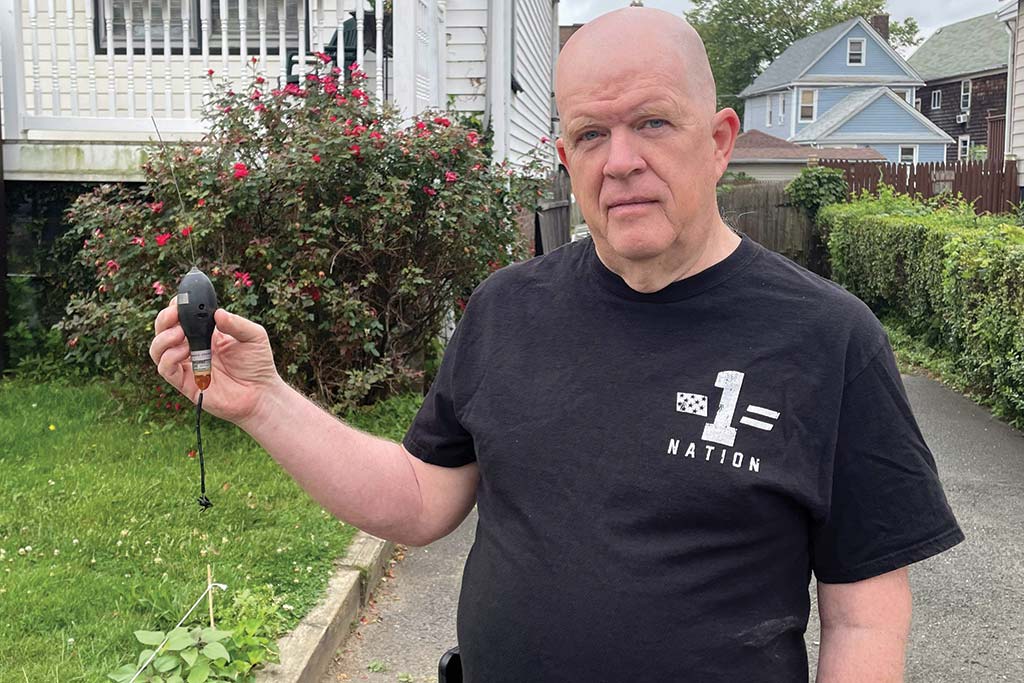
So, What’s Next?
As of the 2021 July Fourth weekend, we have deployed five MiniPSAT devices this season into striped bass from 42 to 46 inches in length. One of those tagged stripers, a 44-incher aboard Chuck Many’s boat Tyman on May 24, 2021, is still out there on the loose, with a tag expected to release during the third week of September. The 42-incher tagged aboard Capt. Frank Wags’ Fin Chasers is the one that disengaged early after just about two weeks. The other NY Bight/Jersey Shore specimen tagged on June 17 is expected to be free of her MiniPSAT in the middle of October. The MiniPSAT devices from those two Montauk fish will hopefully begin their transmission to the Argos Satellites in early November.
Thus far, none of these fish have been officially named. In our July edition of The Fisherman we asked for readers to provide naming ideas that were appropriate for this year’s study. In 2019, we had Liberty and Freedom, followed by Cora and Rona in 2020 off the Jersey Shore with Independence over the 2020 Fourth of July weekend. I’m thinking Mary for our emergency fish aboard Tyman on the 17th of June, only because that 44-incher at Romer Shoal was very much a “Hail Mary” fish of sorts.
And perhaps the premature release – that “needle in a haystack” tag retrieval along the shores of Staten Island – could take the honor of the family of the very first settlers there on August 6, 1661. The Dutch family of Thys Barentsen immigrated from Holland on that date with 21 other families. According to the passenger lists and subsequent genealogical research, Thys’s wife was named Magdelena.
Given the divinity of striped bass in our region, could naming them Mary and Magdelena be any more appropriate?
By the time the sensor data archived in the onboard memory inside each tag (including hourly temperature, pressure, and light data) begins to feed the Argos Satellites and relay that valuable packet of information back to Gray FishTag Research, there are a whole bunch of us here along the Striper Coast praying for the very best out of this year’s study. Praying, and hoping for at least one more deployment soon, this time along the New England coast in an effort to continue tracking these incredible migratory fish.
Read more about the Northeast Striped Bass Study at www.thefisherman.com/category/striped-bass-study.

